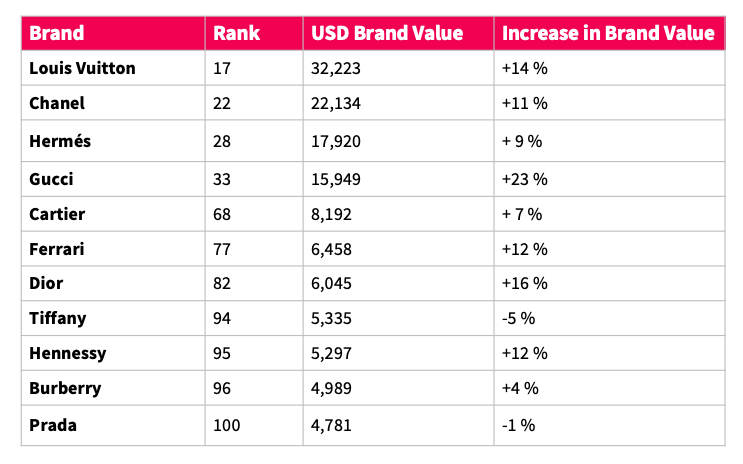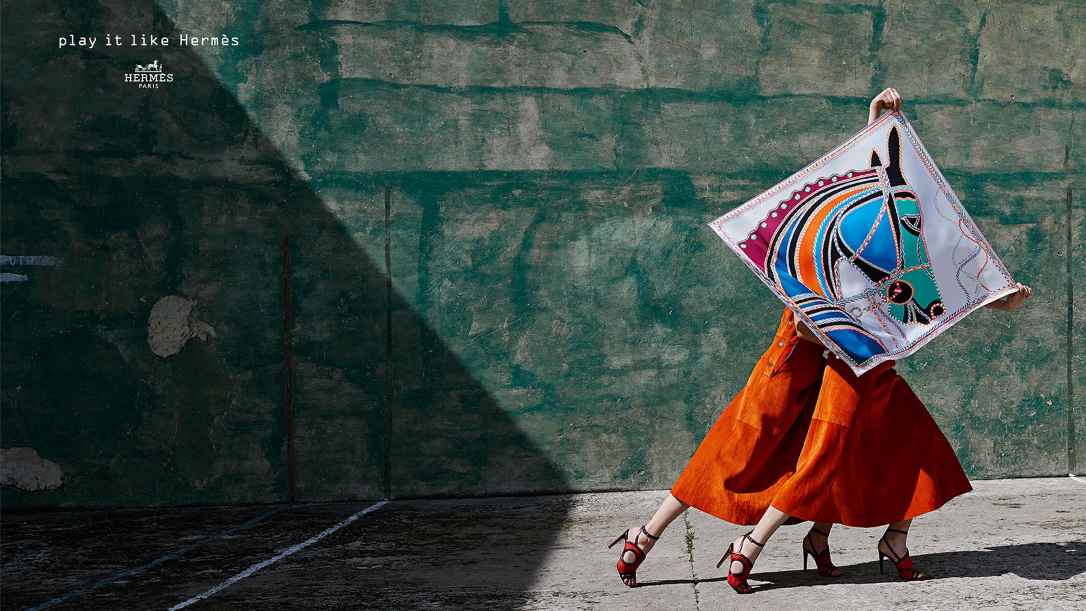
Retail
Opinion: Burberry, Gucci and Hermès Most Iconic Movers in Luxury
by
Rebecca Robins | October 17, 2019
Luxury is an industry that defies classification, it’s not a sector but a space of excellence. As Interbrand celebrates 20 years of its Best Global Brands study, Rebecca Robins, global luxury lead at the brand consultancy, looks at the most iconic brands in the industry, their evolution and what they represent in the context of our times.
Two decades of tracking the world’s most valuable brands holds a vault of data, which, unlocked, affords a powerful lens on the changes that we have seen within brands, on the shifts and disruptions that have played out across industries, and on how we have changed, as both employees and consumers of these brands.
The Interbrand tracker of global brands that have grown and risen up through this time have given witness to an exponential rise of digital and tech, have held strong through a global economic crisis, and today find themselves called to action and a responsibility in business to the greater human demands and good of stakeholders, as much as to the fiscal imperatives of shareholders. Consider the influence of this brand landscape, when the combined total value of these Top 100 brands alone is $2,130,929 million, an increase of 5.7 percent from 2018.
Measured on financial performance, role of brand and brand strength, these are the brands that have outperformed the MSCI and S&P; stock indexes consistently over two decades. We look at what’s changed in 20 years, as the top 100 has seen entrants and exits, brand revivals and brands never to return. As we focus on the luxury brands who now dominate in this study, we’ll look at what’s sustained: the brands who have been there since year one. And we unpack the unprecedented change in the luxury industry, looking at how luxury brands have evolved, in their relationship with culture, and in what they represent for us in the context of our times.
Luxury brands continue to outperform
Luxury continues its reign from last year as the top performing industry across all sectors represented in the 2019 top 100 brands. Gucci emerges again, as one of the top five fastest growing brands across all industries, with a 23 percent increase in brand value, in the company of Amazon (+24 percent), Salesforce (+24 percent), and Starbucks (+23 percent). New entrants this year include Uber (#87) and LinkedIn (#98).
The 2019 luxury landscape is a demonstration of the sheer dominance of brand-driven desire:

The total value of luxury brands in 2000 represented 2 percent of the total value of the table at $21.2 billion (€19.1 billion). This year sees 9 brands exert their dominance in the top 100, with the total value of luxury brands today at $117,785 billion, constituting 6 percent of the total table value. Effectively luxury’s presence as the top performing industry, with an 11 percent increase on 2018, would be even higher if we counted Ferrari and Hennessy.
These are otherwise categorised under ‘automotive’ and ‘consumer goods/alcohol’, respectively. And this is significant, given that luxury is an industry that defies classification. It’s not a sector, it’s a space of excellence that spans everything from fashion and leather goods, to jewellery and watches, to cars and alcohol. These are brands that defy category definition. In many cases they are brands who have broken the rules of their category in their quest for excellence.
As we look at the shape of the industry through the lens of brand value, the landscape of luxury is polarised from the four $15bn+ brands dominating the global landscape, to the $4bn+ and $5bn+ brands at the other end of the scale. Louis Vuitton claims its highest position at No. 17 in its 20 year dominance of the luxury brands in the study, and with a value that’s almost in a league of its own at $32bn+. We also see peak rankings in their history in the study for Hermès, Gucci and Dior. It has been a year of brand revival at Burberry, with a 4 percent increase in brand value after a series of marked declines since 2015. Prada continues to work through a time of transition and change. And it is telling of a brand that has stood on its own terms. As Miuccia Prada stated in a recent interview with The New York Times: “People always say: ‘Why did you want to become big?’ I never wanted to become big. I want to be in touch and curious about people, politics, cultures, countries."
Icons of culture
What constants have we seen over 20 years? How have some companies sustained success? Over 20 years of the study, only 31 brands from the 2000 ranking remaining in the table today. Of the wealth of luxury brands present today, Louis Vuitton and Gucci are the only two that have sustained their presence since the beginning of the study. 137 brands (amongst them Estee Lauder, Nokia, and MTV) have come and gone in the intervening years. Notable exits from the top 100 within luxury and fashion are: Bulgari (2007), Armani (2012), Hugo Boss (2016), and Ralph Lauren (2017).
This year we reflect on the brands that have made iconic moves. When we think about the world of luxury, these are brands that have been the iconic movers of their times and created products that have taken on a life of their own, from the inimitable products icons in the shape of Chanel’s No. 5, from Cartier’s Panthère, and the Hermès Birkin, to brands that have made strategic iconic moves.
Burberry is one such example, as a pioneer in digital in luxury, becoming the first British luxury brand to break through into the Top 100 in 2006. Under the aegis of Angela Ahrendts, the iconic trench found new relevance with new generations, which was propelled by hardwiring the brand into a newly appealing ‘Britishness’ and by being a first mover in digital, social media and tech, when other luxury brands were otherwise less active or even resistant.
Gucci continues to lead the headlines as the fastest growing luxury brand for the second consecutive year. Its exponential rise in the past four years, from #50 to #33 in the top 100, marks the success of its iconic move in connecting a commitment to culture, creativity and innovation on the inside of the business, to a relentless obsession with consumers (both loyal and new).

Hermès 2019 campaign. Photo: Courtesy.
Perhaps one of the greatest iconic moves is that of Hermès, which is a lesson to many businesses in sustainable growth. The brand with a “policy of product, not a policy of image” (in the words of Axel Dumas), has an unparalleled trajectory of brand value. Where other brands have peaked and dipped over 20 years, Hermès has been the only brand to sustain a consistent increase in brand value. It has grown through an uncompromising commitment to the long-term protection and health of the brand. And one of the reasons that it stands apart, as what we define as a meta-luxury brand. By contrast with other luxury brands, influencers are notable by their relative absence and collaborations and partnerships are more singular than plural. QED the success of the Apple Watch Hermès collaboration.
Conscious Consumers and Creators
As we look to the changes that we’ve lived through in the past 20 years, the rise of digital and tech, and its infusion and infiltration in our lives, has been the single most influential move over that time. The launch of the iPhone during the last recession may be seen as emblematic of the catalytic change that ensued for brands and business, and for us all as both employees and consumers. One of the seismic shifts that we have seen in the luxury industry, are the moves that brands have made from exclusive maisons of mystique, to more inclusive open houses. Openness, collaboration and co-creation have proven to be game-changers across the industry, and the brands that are excelling are those who obsess about learning from their customers.
But what changes next? Luxury is not a category that any of the brands that we have tracked over the course of this study have “decided to be in”. Whether these brands have their origins in fashion, leather goods, or jewellery, they all arose from one fundamental purpose: to do something better, to create something better, to seek and set a standard in excellence. As we look ahead twenty years, what will new disruptions in the industry look like? What if we could count on a commitment beyond an individual brand level, to a collective, collaborating on a united front to apply that pioneering DNA in the quest for better, to the greater good?
Join Luxury Society to have more articles like this delivered directly to your inbox
Agendas and change on diversity and inclusion and sustainability are very real for many of these brands. The time is now to set the agenda in excellence in solving problems in ways that are faster, more effective, and have greater impact than anyone else. There are big moves that we are all looking to, that we are holding business, ourselves and each other accountable to. The iconic move of the industry would be to collaborate around a deep and accelerated commitment to change for good, in everything from diversity and inclusion, to sustainability. In twenty years from now, let’s forecast a more powerful narrative on what these brands succeeded in changing for good.
Cover Image: Burberry Autumn/Winter 2019 campaign. Photo: Courtesy.

